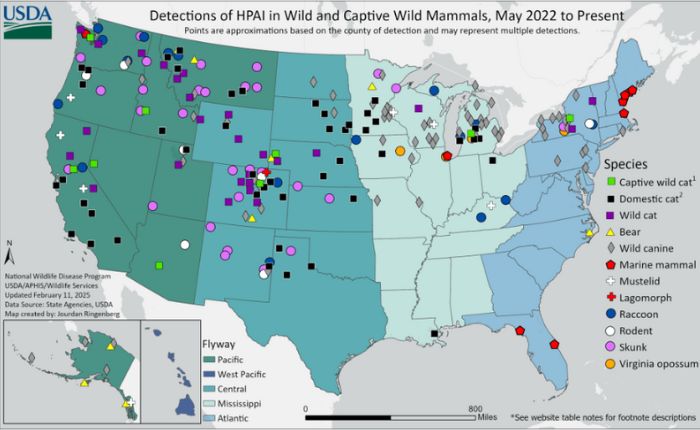Amidst surging respiratory illnesses and previously controlled diseases like tuberculosis making alarming comebacks, a new CDC report provides further evidence bird flu is spreading undetected to humans.
The latest Morbidity and Mortality Weekly Report, whose publication was delayed, details three cases of highly pathogenic avian influenza H5N1 in US veterinarians who work with cattle, with two of the cases lacking a clear source of exposure.
None of the vets experienced any flu-like symptoms, and human-to-human spread is still undetected, but researchers are concerned this ability may only be a few genetic mutations away.
Instead, these cases were detected through antibody tests of 150 veterinarians working across 46 US states in September, revealing bird flu is occurring beyond known zones of infection. One of the veterinarians who tested positive works with livestock in Georgia and South Carolina; neither state has reported bird flu cases in their dairy herds.
"There are clearly infections happening that we're missing," Emory University virologist Seema Lakdawala told Emily Anthes at the New York Times.
Transmission of H5N1 through cow milk has now been experimentally confirmed. In light of all this, health officials are urging all states to join the national milk testing program.
As with any fast-mutating virus, each lapse in containment gives the disease more chances to test random mutations, increasing its opportunity to stumble upon one that will allow it to spread between humans.
"If cases are occurring more frequently than detected in humans, we risk missing small changes that allow the virus to begin to spread much more easily in humans," University of Nebraska infectious disease researcher Lauren Sauer told NPR.
The first case of human H5N1 in Nevada was reported last week, bringing the total known human cases in the US up to 68. Nevada has also just detected a new H5N1 strain in cows, D1.1, that may be better suited to replicating within mammal cells.

"An important part of stopping the transmission of viruses is to track them," Emory University epidemiologist Jodie Guest explained after the US's first human H5N1 death was confirmed on 6 January 2025.
But delays in information sharing due to the freeze on communications from some federal health agencies make this already challenging task even more difficult.
The removal of CDC data already prompted now-contradicted fears about H5N1 cat-to-human transmissions.
KFF Health News reports dairy workers infected cats instead, likely with their work clothing, but this information is still to be released. Data from these health agencies can't currently be accessed elsewhere like they once could.
"CDC right now is not reporting influenza data through the WHO global platforms, FluNet [and] FluID, that they've been providing information [on] for many, many years," WHO epidemiologist Maria Van Kerkhove said in a media brief.
"We are communicating with them, but we haven't heard anything back."
Cases of cat-to-human transmission have occurred with older bird flu strains, but none so far with H5N1. Two more pet cats have been euthanized with the disease after eating raw pet food in Oregon.
Meanwhile, health officials are urging us all to keep ourselves and pets away from raw dairy products, avoid feeding pets raw meat, avoid interacting with wildlife, and wear protective gear if handling potentially infected livestock.
Signs of infection in animals include fever, drowsiness, lack of coordination, moving in circles, a head tilt, and/or an inability to stand or fly, and should be reported to local authorities.
The CDC's Morbidity and Mortality Weekly Report can be read here.
